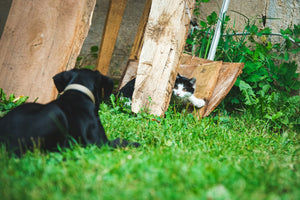3 min read • By Leena Chitnis, Founder, Timberdog
If your dog has a knack for chasing squirrels, rabbits, cats, or even the occasional blowing leaf, you’ve probably uttered the phrase, “My dog has insane prey drive!” Whether you say it with pride, frustration, or both, having a dog with high prey drive is a unique experience—one that requires patience, creativity, and a good sense of humor.
Let’s dive into what prey drive is, how to recognize it, and most importantly, how to channel that energy into something positive.
What Is Prey Drive, Anyway?
Prey drive is an instinctive behavior rooted in a dog’s ancestry. It’s the hardwired urge to stalk, chase, and capture moving targets—a trait that once made them excellent hunters and providers. While all dogs have some level of prey drive, the intensity varies widely between breeds and individual personalities.
Signs of high prey drive include:
-
Hyper-focus on moving objects, like birds, cyclists, or other animals.
-
Darting off in pursuit of “prey” with little regard for commands.
-
Obsessive behavior, like staring out the window for hours, waiting for a target.
-
Strong reactions to noises or sudden movements.
Breeds like Border Collies, Terriers, and Huskies often exhibit high prey drive, but any dog can have it. If your pup seems to view the world as one big game of “chase,” you’ve got yourself a high-drive dog.
The Challenges of Living with a High-Drive Dog
Managing a dog with intense prey drive can feel like you’re constantly on high alert. Here are some common hurdles:
-
Safety Concerns: Dogs with strong prey drive might bolt across busy streets or scale fences to chase after prey.
-
Training Setbacks: Commands like “come” or “leave it” may be ignored when your dog is in the zone.
-
Stressful Walks: Encounters with wildlife or other distractions can turn a leisurely stroll into a tug-of-war.
But it’s not all chaos and frustration. With the right tools and techniques, you can harness your dog’s drive and create a more balanced, enjoyable relationship.
Strategies for Managing Prey Drive
1. Understand Your Dog’s Triggers
Every dog has specific triggers that set off their prey drive. For some, it’s small animals like squirrels or rabbits; for others, it could be moving vehicles or even joggers. Take note of what gets your dog’s attention and plan accordingly.
2. Prioritize Safety
Safety should always come first with a high-drive dog. Consider the following:
-
First of all, do you have enough strength and body weight for large breeds that could suddenly pull or yank on a leash? I've seen many a proud dog owners go flying (especially smaller women and children) when their dogs take off.
-
Use a sturdy harness and leash combo to prevent sudden escapes.
-
Invest in a GPS tracker for your dog’s collar in case they do manage to bolt.
-
Opt for fenced-in areas where your dog can run freely without the risk of chasing something dangerous.
3. Practice Impulse Control
Impulse control exercises are essential for teaching your dog to pause and think before acting.
-
Leave It: Start by teaching your dog to leave treats alone, then gradually work up to more tempting distractions.
-
Wait: Use this command during feeding time, before opening doors, and on walks to reinforce self-control.
-
Recall Games: Make coming back to you the most exciting option, using high-value rewards (i.e., stinky treats like bits of cheese) and enthusiastic praise.
4. Channel Their Energy
High-drive dogs thrive when given an outlet for their instincts. Here are some activities to try:
-
Fetch and Frisbee: These games mimic the chase and capture sequence, giving your dog a satisfying workout.
-
Scent Work: Engage their nose with hide-and-seek games or scent detection training.
-
Tug-of-War: This provides an outlet for their drive to “capture” and “succeed.”
-
Agility Training: High-drive dogs often excel at agility, which channels their energy into focused, productive tasks.
5. Manage the Environment
Reduce the chances of triggering your dog’s prey drive by managing their environment:
-
Avoid high-traffic areas for wildlife during walks.
-
Use window film or curtains to block the view of tempting prey outside until your dog can handle seeing things that move outside the window.
-
Keep your yard secure and free of critters whenever possible.
6. Build a Solid Relationship
Prey drive is instinctual, but a strong bond with your dog can make a world of difference. Spend quality time together, using positive reinforcement to build trust and communication. The more your dog values you as their leader and companion, the more they’ll look to you for guidance—even in the face of distractions.
When to Seek Professional Help
If your dog’s prey drive feels unmanageable, don’t hesitate to enlist the help of a professional trainer or behaviorist. Look for someone experienced with high-drive dogs who can tailor a plan to your dog’s needs.
Final Thoughts
A dog with high prey drive can be a handful, but they’re also incredibly fun, energetic, and rewarding companions. By understanding their instincts and providing the right outlets, you can turn their drive into an asset rather than a challenge. Remember: it’s not about eliminating prey drive—it’s about working with it in a way that keeps everyone safe and happy.
So, next time your dog bolts after a squirrel, take a deep breath, hold tight to that leash, and remember: you’re not alone in this wild ride. And hey, maybe your dog does have more prey drive than mine—but I’m not going to argue with you about it!
Photo credit: Guillaume de Germain

